Zoom
Trash

John Brown & Company. Marathon Oil bought the Clydebank shipyard from UCS and used it to build oil rig platforms for the North Sea oil industry.
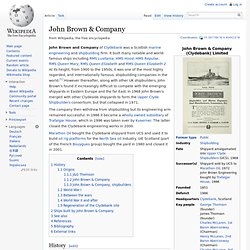
UiE Scotland (part of the French Bouygues group) bought the yard in 1980 and closed it in 2001. History[edit] Origins[edit] J&G Thomson[edit] The brothers separated their business association in 1850 and, after an acrimonious split, George took over the shipbuilding end of the association. Despite intermittent financial difficulties the company developed a reputation based on engineering quality and innovation. John Brown & Company (Clydebank) Ltd. The brothers, James and George Thomson founded the renowned shipbuilding business at Cessnock in 1851.
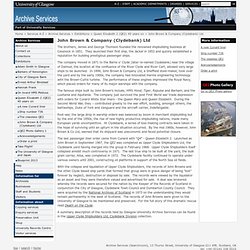
They launched their first ship, the Jackal in 1852 and quickly established a reputation for building prestigious passenger ships. The company moved in 1871 to the Barns o' Clyde (later re-named Clydebank) near the village of Dalmuir, the location at the confluence of the River Clyde and River Cart, allowed very large ships to be launched. In 1899, John Brown & Company Ltd, a Sheffield steel-maker, took over the yard and by the early 1900s, the company had innovated marine engineering technology with the Brown-Curtis turbine.
The performance of these engines impressed the Royal Navy, which placed orders for many of its major warships with the company. The famous ships built by John Brown’s include, HMS Hood, Tiger, Repulse and Barham, and the Lusitania and Aquitania. (former) John Brown's Shipyard - Clydebank. Clydebank Shipyard was probably the most significant shipyard in the world from the late 1800s until World War 2.
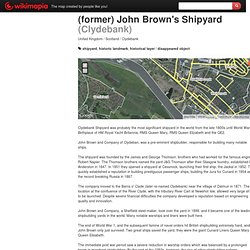
Birthplace of HM Royal Yacht Britannia, RMS Queen Mary, RMS Queen Elizabeth and the QE2. John Brown and Company of Clydeban, was a pre-eminent shipbuilder, responsible for building many notable ships. The shipyard was founded by the James and George Thomson, brothers who had worked for the famous engineer Robert Napier. The Thomson brothers named the yard J&G Thomson after their Glasgow foundry, established in Anderston in 1847. In 1851 they opened a shipyard at Cessnock, launching their first ship, the Jackal in 1852.
Ships and Harbours Photos - John Brown and Company, Clydebank, UK. The Clydebank shipyard of John Brown and Company, Clydebank, Scotland, is probably the best known of any of the Clyde shipyards world wide even by non- maritime people.The shipyard was founded by brothers James and George Thomson who established two shipyards in Glasgow in 1847 and 1851.
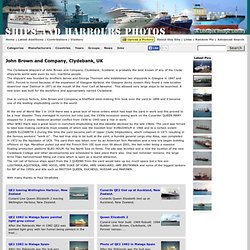
Forced to move because of the expansion of Glasgow Harbour, the Glasgow docks system they found a new location downriver near Dalmuir in 1871 at the mouth of the river Cart at Newshot . This allowed very large ships to be launched. A new town was built for the workforce and appropriately named Clydebank. Due to various factors, John Brown and Company, a Sheffield steel-making firm took over the yard in 1899 and it became one of the leading shipbuilding yards in the world. At the end of World War I in 1918 there was a great lack of naval orders which had kept the yard in work and this proved to be a near disaster. With many thanks to Paul Strathdee. Feature: The Story of the Clyde Bank Shipyard. List of ships built by John Brown & Company. Clydebuilt Ships Database - ships and shipbuilders on the River Clyde - 2012 Clydebuilt Ships Database. {*style:<b> Home Search For Ships On This Day Featured Updates Clydebuilt & Active Static Ships Featured Ship Type Recent Updates </b>*} {*style:<b> Clydebuilt Slideshow </b>*} New: Clyde Videos Browse 2002's Clydesite </b>*} Further Resources: JWM's Clydebuilt Warships {*style:<b>Show Random Ship {*style:<b>Other Sites Clydesite Hub Clyde Ship Management Clyde Shipping TugTalk.
John Brown's Shipyard, Clydebank: famous Clyde Shipyard building great liners & warships - Clyde Waterfront Heritage. John Brown’s shipyard has a special place in the history of Clyde shipbuilding.
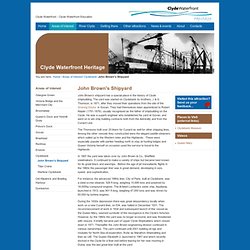
The yard was started on Clydebank by brothers, J & G Thomson, in 1871, after they moved their operations from the site of the Graving Docks in Govan. They had themselves been apprenticed to Robert Napier (1791-1876), usually recognised as the father of shipbuilding on the Clyde. He was a superb engineer who established his yard at Govan, and went on to win ship building contracts both from the Admiralty and from the Cunard Line.
The Thomsons built over 20 liners for Cunard as well for other shipping lines. Clydebank history & industrial heritage: John Brown's Shipyard, Titan Crane, Wartime Clydebank - Clyde Waterfront Heritage. John Brown's Shipyard. Site Record for Clydebank, Kilbowie, John Brown's Shipyard J & G Thomson; Queen's Quay; Barns Of Clyde; Clydebank Shipyard; Clydebank Shipbuilding Yard; Marathon YardDigital_images Digital_images. John Brown's Shipyard, Clydebank, Queen Mary under construction. Oblique aerial photograph taken facing east. The image toolbar Please note that you need to be registered and logged in to access certain features on the image toolbar.

The image toolbar below each Aerofilms image offers the follwing options: "Love this" The "Love this" button allows you to indicate if you love the image. Clicking on "Love this" will mean that the image becomes one of the five images shown on the homepage slideshow. Adding a pin. A riveting squad at work at John Brown's shipyard, Glasgow in 1949. JOHN BROWN'S SHIPYARD. John Brown's Shipyard, Clydebank, ship under construction. Oblique aerial photograph taken facing north-east. This image has been produced from a print. The image toolbar Please note that you need to be registered and logged in to access certain features on the image toolbar.
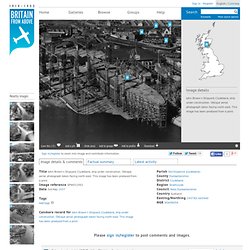
The image toolbar below each Aerofilms image offers the follwing options: "Love this" The "Love this" button allows you to indicate if you love the image. Clicking on "Love this" will mean that the image becomes one of the five images shown on the homepage slideshow. Adding a pin. Clydebank, Kilbowie, John Brown's Shipyard. RMS Lusitania.
HMS Hood (51) HMS Hood (pennant number 51) was the last battlecruiser built for the Royal Navy. Commissioned in 1920, she was named after the 18th-century Admiral Samuel Hood. One of four Admiral-class battlecruisers ordered in mid-1916, Hood had serious design limitations, though her design was drastically revised after the Battle of Jutland and improved while she was under construction.
For this reason she was the only ship of her class to be completed. HMS Hood. RMS Queen Mary. Queen Mary sailed on her maiden voyage on 27 May 1936 and captured the Blue Riband in August of that year; she lost the title to SS Normandie in 1937 and recaptured it in 1938.

With the outbreak of World War II, she was converted into a troopship and ferried Allied soldiers for the duration of the war. Following the war, Queen Mary was refitted for passenger service and along with Queen Elizabeth commenced the two-ship transatlantic passenger service for which the two ships were initially built. The two ships dominated the transatlantic passenger transportation market until the dawn of the jet age in the late 1950s. By the mid-1960s Queen Mary was aging and though still among the most popular transatlantic liners, was operating at a loss. After several years of decreased profits for Cunard Line, Queen Mary was officially retired from service in 1967. Construction and naming[edit] Overhead view of Queen Mary docked at Long Beach in 2008 History (1934–1939)[edit]
RMS Queen Elizabeth. RMS Queen Elizabeth was an ocean liner operated by the Cunard Line.
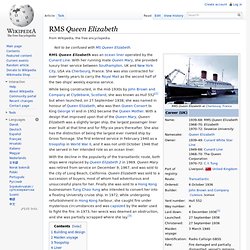
With her running mate Queen Mary, she provided luxury liner service between Southampton, UK and New York City, USA via Cherbourg, France. RMS Queen Elizabeth. HMY Britannia. Construction[edit] HMY Britannia was built at the shipyard of John Brown & Co.
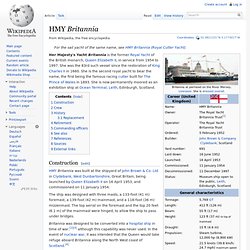
Ltd in Clydebank, West Dunbartonshire, Great Britain, being launched by Queen Elizabeth II on 16 April 1953, and commissioned on 11 January 1954. The ship was designed with three masts, a 133-foot (41 m) foremast, a 139-foot (42 m) mainmast, and a 118-foot (36 m) mizzenmast.
Queen Elizabeth 2. Queen Elizabeth 2, often referred to simply as QE2, is an ocean liner built for the Cunard Line which was operated by Cunard as both a transatlantic liner and a cruise ship from 1969 to 2008. She was designed for the transatlantic service from her home port of Southampton, UK, to New York, and was named after the earlier Cunard liner RMS Queen Elizabeth. She served as the flagship of the line from 1969 until succeeded by RMS Queen Mary 2 in 2004. Designed in Cunard's then headquarters and regional offices in Liverpool and Southampton respectively, and built in Clydebank, Scotland, she was considered to be the last of the great transatlantic ocean liners until the construction of the Queen Mary 2 was announced. Before she was refitted with a diesel power plant in 1986/87, QE2 was also the last oil-fired passenger steamship to cross the Atlantic in scheduled liner service. QE2 retired from active Cunard service on 27 November 2008.
Characteristics[edit] History[edit] Service history[edit]